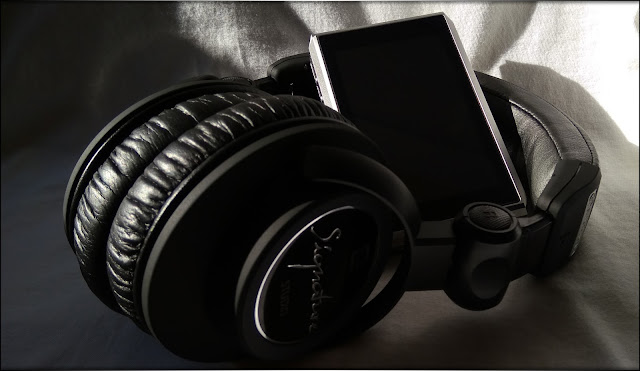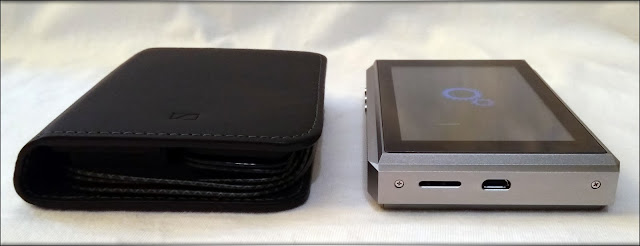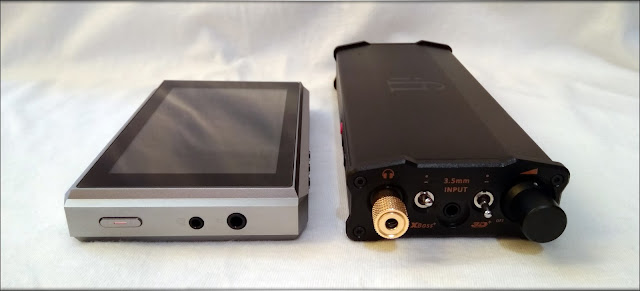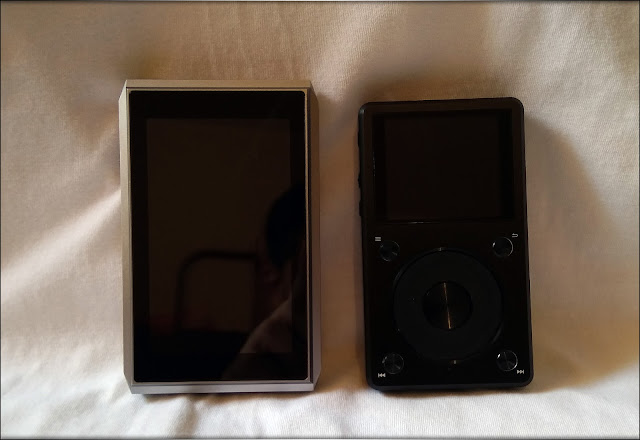The Audio-Opus Opus#3 Dap Review - Expatinjapan

Opus#3 and PlusSound Exo Series cable.
Audio-Opus, TheBit, Opus#3 review
-expatinjapan
 http://www.audio-opus.com/?page_id=17235
http://www.audio-opus.com/?page_id=17235
Thank you to Audio-Opus/TheBit for sending Head pie the Opus#3 for review.
`TheBit has created the most optimized solution for all music lovers to really feel what musicians feel and hear what they hear in Hi-fi & Hi-Res audio formats. Opus#3 will allow you to enjoy your favorite music in best sound quality up to 24bit/192kHz, providing unforgettable experience and unique sensations from the original sound.` - From the Audio-Opus website.

Opus#3 and Jomo - `Pretty little beast`
with Double Helix Cables Pure OCC Silver Litz IEM cable
Head pie reviewed the Opus#1 at an earlier stage, see here for the review:
http://headpie.blogspot.jp/2016/07/the-bit-opus1-dap-review-expatinjapan.html
Build

Metal Body ( Tempered Aluminum ) with a plastic back and a metal volume wheel.


Single ended 3.5mm out, and 2.5mm balanced out, on/off switch.

Micro SD slot, micro USB charging port.

FF, Play, Reverse buttons.

Size comparison between Opus#1 and Opus#3 Daps.

Opus#3 Dap booting up.

Opus#3 with Meze 99 Neo headphones.


Opus#3 and Opus#1 size comparison without the leather Dignis cases.
(With Campfire Audio Andromeda and ALO Audio Reference 8 balanced cable)



Opus#3 dap with the Dignis leather case.


 Specifications
Specifications
-Native DSD Playback (X-MOS Include)
-24bit / 192kHz High Resolution Sound
-4” Touch display (IPS Panel)
-Burr-Brown PCM1792A DAC
-ARM Cortex-A9 1.4GHz, Quad-Core CPU & DDR3 1GB
-Internal Memory 64GB
-External microSD card up to 256GB
-Metal Body ( Tempered Aluminum ), Metal Wheel Volume
-WI-FI : 801.11b/g/n ( 2.4GHz )
-Bluetooth 4.0( A2DP, AVRCP )
-Ultra Power Saving Mode
-Supports 3rd Party Streaming Application
 Model Opus#3(HA-530)
Model Opus#3(HA-530)
-CPU & RAM ARM Cortex-A9 1.4GHz, Quad-Core & DDR3 1GB
-Display 4″ TFT Touch Display(480*800) IPS PANEL
-Button POWER, PLAY/PAUSE, FF, REW VOLUME(WHEEL)
-Supported Audio Formats WAV, FLAC, ALAC, AIFF, WMA, MP3, OGG,APE(Normal, High, Fast), native DSD(DFF,DSF)
-Sample rate PCM : 16kHz ~ 192Hz (8/16/24bits per Sample)
DSD Native: DSD64(1bit 2.8MHz, Stereo),
DSD128(1bit 5.6MHz, Stereo),
DSD256(1bit 11.2MHz, Stereo)
-EQ & Effect EQ:10Band NORMAL/USER1/2/3/4/5
-Input USB Micro-B input (for charging & data transfer (PC & MAC))
Connection Mode : MTP (Media Device)
-Outputs Phone (3.5mm) / Optical Out (3.5mm)
Balanced Out(2.5mm, 4-pole support)
-Wi-Fi 802.11 b/g/n (2.4GHz)
-Bluetooth V4.0 (A2DP, AVRCP)
-Feature Enhancements Firmware upgrades supported (OTA)
-Battery 4,000mAh/3.7V Li-Polymer
-Battery Life(Play) Time & Charge Time Play: Approximately 8.5 hours.
Charge:4 hours
-Memory Built-in 64GB
External microSD (up to 256GB) / Supports SDXC (exFAT, NTFS)
-Clock source / Jitter 50ps(Typ)
-OS Customized Android 5.1.1
-Supported OS Windows 7,8,10 (32/64bit), MAC OS x 10.9 and up
Audio Performance
-DAC Burr-Brown PCM1792A
-Decoding Support up to 24bit / 192kHz Bit to Bit Decoding
-Frequency Response ±0.026dB(Condition: 20Hz~20KHz) Unbalanced & Balanced
±0.3dB(Condition: 10Hz~70KHz) Unbalanced & Balanced
-Signal to Noise Ratio 114dB @ 1KHz, Unbalanced
114dB @ 1KHz, Balanced
-Crosstalk 130dB @ 1KHz,Unbalanced / 135dB @ 1KHz, Balanced
THD+N 0.0009% @ 1KHz
-Output Impedance Balanced out 2.5mm(1ohm) / Phone 3.5mm(2ohm)
-Output Level Balance 3.0Vrms / Unbalance 2.5Vrms(Condition No Load)
-Volume Step 150 steps
-Gapless O
 Sound
Sound
The Opus#3 was burned in for over 150 hours to satisfy the burn in fans and the rest say it doesnt matter, so everyone is a winner.
I used mostly 16/44 FLAC and also some more hi res tracks. Mostly I used shuffle mode as I like the unexpected tracks when testing as it keeps me on my toes and also means I listen to tracks I would otherwise skip over.
I tested the Opus#3 in a variety of situations, at home, on the train, walking, cafes etc.
Many different earphones and cables were used during the listening and testing period, some of them pictured in the various rig photos to give me a sense of the true Opus#3 sound.

Opus#3 and Simgot EN700 Bass
I usually write quite a bit about Daps I review but feel I can use a bit more brevity when talking about the Opus#3.
The Opus#3 is a a Dap that fits within its asking price quite comfortably, perhaps due to its many functions.
The sound is a clean, natural and accurate signature.
I find I enjoy the 1ohm balanced port more than the 2ohm single ended port. Its more accurate, has more control and cleaner for my many multi driver IEMs.
the smoothness of the extra ohm on the single end would appeal to many who intend to pair the Opus#3 with sub $500 or so earphones.
At no time did I feel the Opus#3 to be lacking in general terms of resolution or power. Whilst not a super beast in terms of amplifying power it is more than enough for its intended portable use.
With a UI that is easy to use, lightweight within ones hand and a sensible size i was quite taken with the Opus#3.
Its tonality is like the eye of Sauron.

Opus#3 and Campfire Audio Vegas
The specs reveal the Opus#3 to be similar generally to the Opus#1 (not taking into account the added bells and whistles, wifi etc)
.
But is the sonic performance the same?
I connected the Opus#1 and Opus#3 to a headphone switcher and volume tested them with a SPL app to get a near enough matching volume level to try to discern the differences.

I found the Opus#3 to be more resolving overall.
The Opus#1 has a vocals forward signature at ordinary volumes, whereas with the Opus#3 seems the music is up with the vocals, making the sound more engaging and richer and there is more definition.
The sound stage on the Opus#3 is much larger than on Opus#1, on height and width. Making the Opus#3 more exciting, intimate and engaging. But its incremental and not absolute.
The Opus#3 sound stage is increased in the width, slightly in the height whilst not much more in the depth.
The sound stage increases when using the balanced out, as does instrument separation.
They both retain the characteristic smoothness of the Opus brand, more so when using the 2ohm single ended out, things get a bit more apart when using the balanced out.
Instrument separation is cleaner on the Opus#3.
When I turn up the volume louder the Opus#3 seems to cope better with it.
In summary, its very close to call in terms of sonics but the Opus#3 just pulls ahead on the single end, and more so on the balanced out.
In terms of extended listening sessions I would pick the Opus#3 over the Opus#1.
The Burr-Brown dac just adding that extra little something.

Opus#3 Dap with Campfire Audio Andromeda and Alo Audio Reference 8 balanced cable.
Size

The Opus#3 fits nicely in ones palm.
Features
I didn`t try out all the various features that the Opus#3 has to offer due t my stubborn luddite old school backwards attitude and way of life. Streaming?, meh more like screaming.
I had no trouble connecting the Opus#3 to the ifi Nano iOne which is connected to my simple home mini system of Onkyo CR-N765 with D-112EXT speakers. I found connectivity better without the leather case and was able to walk around the room without loss of connectivity.
Wifi I mainly used for updating the firmware without any hitches.
The USB DAC certainly improved the audio output of my Macbook pro. the set up was easy and quality of audio excellent.

Opus#3 via Bluetooth to ifi Nano iOne DAC to Onkyo CR-N765.
Value
The Opus#3 retails for US$899.
This price fits in nicely between the two forerunner Opus daps.
Opus#1 retailing at US$350 - US$599, and the Opus#2 Dap retailing at US$1,100 - US$1,599 (depending on current deals).
Musicteck in the USA have some good deals on all the Opus daps
https://shop.musicteck.com/collections/opus
I reviewed the Opus#1 previously (and still use it) and have only spent brief listening sessions with the Opus#2 at audio shows.
I have covered the similarities and differences in sound signature with the Opus#1 in the sound section.
The value lies more in what extras do you want?
Opus#3:
A slightly more increase in resolution?
Wifi?
Streaming music?
Apps?
Bluetooth?
USB DAC function?
And:
One Burr-Brown DAC (Opus#3) versus two Cirrus DACs in Opus#1.
Opus#3 supports 9+1 (aac) audio codecs, Opus#1.
Metal and plastic casing - Opus#3, versus plastic- Opus#1.
One Micro SD card slot versus two slots on the Opus#1.
It all depends on functions needed/wanted for each persons intended use as to the value in this case.

Opus#3 Dap, Jomo6R and Double Helix Cable Pure OCC Silver Litz IEM cable
Overall
The Opus#3 is the third in the Opus series of Daps, the #3 fitting nicely in between the #1 and the #2.
For those of you who may be confused at the numbering system:
The first is Opus#1,
The second is Opus#2,
The third is Opus#3...
Product names are Opus#1 (HA-501), Opus#2(HA-600), Opus#3(HA-530).
I reviewed the Opus#1 earlier and the UI navigation screens are the same. Take the link for the UI photos
http://headpie.blogspot.jp/2016/07/the-bit-opus1-dap-review-expatinjapan.html
The Opus#3 delivers a clean, nearly neutral and with a dash of warmth sound.
The UI is easy to use and responsive.
Firmware updates are simple via wifi.
I found the Bluetooth to be strong, wifi connectivity is easy and the USB DAC function excellent.
The volume wheel has a generous 150 steps, and is firm enough and protected against sudden increases in volume by the leather case. The leather case can loosen the wheel a bit, but I was able to retighten it myself.
Its quite close to its cheaper sibling the Opus#1 but does edge it out, especially in longer listening sessions or when using the balanced out.
Much of the operating system is the same when comparing the specifications. But the devil is in the details and the proof of the pudding is in the tasting. Opus#3=Yum.
I ended up preferring the easy sound of the Opus#3 at the end of each listening session, I would happily plug the balanced cable back into the Opus#3, then slowly change it back to the Opus#1.
Although change from two Cirrus Dacs (Opus#1) to a single Burr brown the Opus#3 loses nothing but seems to gain in smoothness, clarity, detail, sound stage and resolution overall.
I would have liked a bit more power under the hood - but I generally didn`t max much past 80-90 on the volume side of things. And I do like to listen louder than most. It was more than satisfactory.
The Opus#1 is definitely no slouch and has earned a stellar reputation for its many virtues, the Opus#3 just edges it out in sound, and of course overall features.
The different features are listed in the value section.
The Opus#3 is a device that can meet the multi media needs of the majority of todays demanding audiophiles, who desire a variety of functions from their dap of choice.

Thank you to TheBit Audio-Opus for sending Head pie the Opus#3 for review



















































































